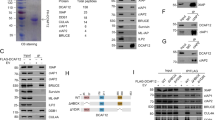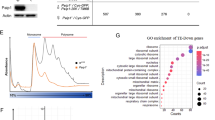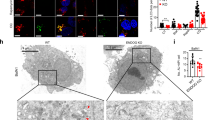Abstract
Cell death in higher organisms is negatively regulated by Inhibitor of Apoptosis Proteins (IAPs), which contain a ubiquitin ligase motif, but how ubiquitin-mediated protein degradation is regulated during apoptosis is poorly understood. Here, we report that Drosophila melanogaster IAP1 (DIAP1) auto-ubiquitination and degradation is actively regulated by Reaper (Rpr) and UBCD1. We show that Rpr, but not Hid (head involution defective), promotes significant DIAP1 degradation. Rpr-mediated DIAP1 degradation requires an intact DIAP1 RING domain. Among the mutations affecting ubiquitination, we found ubcD1, which suppresses rpr-induced apoptosis. UBCD1 and Rpr specifically bind to DIAP1 and stimulate DIAP1 auto-ubiquitination in vitro. Our results identify a novel function of Rpr in stimulating DIAP1 auto-ubiquitination through UBCD1, thereby promoting its degradation.
This is a preview of subscription content, access via your institution
Access options
Subscribe to this journal
Receive 12 print issues and online access
$209.00 per year
only $17.42 per issue
Buy this article
- Purchase on SpringerLink
- Instant access to full article PDF
Prices may be subject to local taxes which are calculated during checkout







Similar content being viewed by others
References
Jacobson, M. D., Weil, M. & Raff, M. C. Programmed cell death in animal development. Cell 88, 347–354 (1997).
Hengartner, M. O. The biochemistry of apoptosis. Nature 407, 685–687 (2000).
Goyal, L. Cell death inhibition: keeping caspases in check. Cell 104, 805–808 (2001).
Hay, B. A., Wassarman, D. A. & Rubin, G. M. Drosophila homologs of baculovirus inhibitor of apoptosis proteins function to block cell death. Cell 83,1253–1262 (1995).
Wang, S. L., Hawkins, C. J., Yoo, S. J., Muller, H. A. & Hay, B. A. The Drosophila caspase inhibitor DIAP1 is essential for cell survival and is negatively regulated by HID. Cell 98, 453–463 (1999).
Goyal, L., McCall, K., Agapite, J., Hartwieg, E. & Steller, H. Induction of apoptosis by Drosophila reaper, hid and grim through inhibition of IAP function. EMBO J. 19, 589–597 (2000).
Lisi, S., Mazzon, I. & White, K. Diverse domains of THREAD/DIAP1 are required to inhibit apoptosis induced by REAPER and HID in Drosophila. Genetics 154, 669–678 (2000).
Wu, J. W., Cocina, A. E., Chai, J., Hay, B. A. & Shi, Y. Structural analysis of a functional DIAP1 fragment bound to grim and hid peptides. Mol. Cell 8, 95–104 (2001).
White, K., Grether, M. E., Abrams, J. M., Young, L., Farrell, K. & Steller, H. Genetic control of programmed cell death in Drosophila. Science 264, 677–683 (1994).
Du, C., Fang, M., Li, Y., Li, L. & Wang, X. Smac, a mitochondrial protein that promotes cytochrome c-dependent caspase activation by eliminating IAP proteins. Cell 102, 33–42 (2000).
Verhagen, A. et al. Identification of DIABLO, a mammalian protein that promotes apoptosis by binding to and antagonizing IAP proteins. Cell 102, 43–54 (2000).
Hegde, R. et al. Identification of Omi/HtrA2 as a mitochondrial apoptotic serine protease that disrupts IAP-caspase interaction. J. Biol. Chem. 277, 432–438 (2002).
Martins, L. M. et al. The serine protease Omi/HtrA2 regulates apoptosis by binding XIAP through a Reaper-like motif. J. Biol. Chem. 277, 439–444 (2002).
Suzuki, Y. et al. A serine protease, HtrA2, is released from the mitochondria and interacts with XIAP, inducing cell death. Mol. Cell 8, 613–621 (2001).
Verhagen, A. et al. HtrA2 promotes cell death through its serine protease activity and its ability to antagonise inhibitor of apoptosis proteins. J. Biol. Chem. 277, 445–454 (2001).
Joazeiro, C. A. & Weissman, A. M. RING finger proteins: mediators of ubiquitin ligase activity. Cell 102, 549–552 (2000).
Huang, H. K. et al. The inhibitor of apoptosis, cIAP2, functions as a ubiquitin protein ligase and promotes in vitro monoubiquitination of caspase 3 and 7. J. Biol. Chem. 275, 26661–26664 (2000).
Suzuki, Y., Nakabayashi, Y. & Takahashi, R. Ubiquitin-protein ligase activity of X-linked inhibitor of apoptosis protein promotes proteasomal degradation of caspase-3 and enhances its anti-apoptotic effect in Fas-induced cell death. Proc. Natl Acad. Sci. USA 98, 8662–8667 (2001).
Yang, Y., Fang, S., Jensen, J. P., Weissman, A. M. & Ashwell, J. D. Ubiquitin protein ligase activity of IAPs and their degradation in proteasomes in response to apoptotic stimuli. Science 288, 874–877 (2000).
Blair, S. S. Mechnisms of compartment formation: evidence that non-proliferating cells do not play a critical role in defining the D/V lineage restriction in the developing wing of Drosophila. Development 119, 339–351 (1993).
Clem, R. J., Fechneimer, M. & Miller, L. K. Prevention of apoptosis by a baculovirus gene during infection of insect cells. Science 254, 1388–1390 (1991).
Brand, A. H. & Perrimon, N. Targeted gene expression as a means of altering cell fates and generating dominant phenotypes. Development 118, 401–415 (1993).
Baker, N. E. & Yu, S. Y. The EGF receptor defines domains of cell cycle progression and survival to regulate cell number in the developing Drosophila eye. Cell 104, 699–708 (2000).
Srinivasan, A. et al. In situ immunodetection of activated caspase-3 in apoptotic neurons in the developing nervous system. Cell Death Differ. 5, 1004–1016 (1998).
Bergmann, A., Agapite, J., McCall, K. & Steller, H. The Drosophila gene hid is a direct molecular target of Ras-dependent survival signaling. Cell 95, 331–341 (1998).
Kurada, P. & White, K. Ras promotes cell survival in Drosophila by downregulating hid expression. Cell 95, 319–329 (1998).
Wilson, P. et al. The RING finger of DIAP1 is essential for regulating apoptosis. Nature Cell Biol. DOI: 10.1038/ncb799.
Saville, K. J. & Belote, J. M. Identification of an essential gene, l(3)73Ai, with a dominant temperature-sensitive lethal allele, encoding a Drosophila proteasome subunit. Proc. Natl Acad. Sci. USA 90, 8842–8846 (1993).
Fischer-Vize, J. A., Rubin, G. M. & Lehmann, R. The fat facets gene is required for Drosophila eye and embryo development. Development 116, 985–1000 (1992).
Treier, M., Seufert, W. & Jentsch, S. Drosophila UbcD1 encodes a highly conserved ubiquitin conjugating enzyme involved in selective protein degradation. EMBO J. 11, 367–372 (1992).
Cenci, G. et al. ubcD1, a Drosophila ubiquitin-conjugating enzyme required for proper telomere behaviour. Genes Dev. 11, 863–875 (1997).
Neufeld, T. P., Tang, A. H. & Rubin G. M. A genetic screen to identify components of the sina signaling pathway in Drosophila eye development. Genetics 148, 277–286 (1998).
Matuschewski, K., Hauser, H. P., Treier, M. & Jentsch, S. Identification of a novel family of ubiquitin-conjugating enzymes with distinct amino-terminal extensions. J. Biol. Chem. 271, 2789–2794 (1996).
Meier, P., Silke, J., Leevers, S. J. & Evan, G. I. The Drosophila caspase DRONC is regulated by DIAP1. EMBO J. 19, 598–611 (2000).
Quinn, L. M. et al. An essential role for the caspase dronc in developmentally programmed cell death in Drosophila. J. Biol. Chem. 275, 40416–40424 (2000).
Xu, T. & Rubin, G. M. Analysis of genetic mosaics in developing and adult Drosophila tissues. Development 117, 1223–1237 (1993).
Kanuka, H. et al. Control of the cell death pathway by Dapaf-1, a Drosophila Apaf-1/CED-4-related caspase activator. Mol. Cell 4, 757–769 (1999).
Rodriguez, A. et al. Dark is a Drosophila homologue of Apaf-1/CED-4 and functions in an evolutionarily conserved death pathway. Nature Cell Biol. 1, 272–279 (1999).
Gaumer, S., Guenal, I., Brun, S., Theodore, L. & Mignotte, B. bcl-2 and bax mammalian regulators of apoptosis are functional in Drosophila. Cell Death Differ. 7, 804–814 (2000).
Baehrecke, E. H. Steroid regulation of programmed cell death during Drosophila development. Cell Death Differ. 7, 1057–1062 (2000).
Lee, C. Y. et al. E93 directs steroid-triggered programmed cell death in Drosophila. Mol. Cell 6, 433–443 (2000).
Jiang C., Lamblin, A. F., Steller H. & Thummel C. S. A steroid-triggered transcriptional hierarchy controls salivary gland cell death during Drosophila metamorphosis. Mol. Cell 5, 445–455 (2000).
Tamm et. al. Expression and prognostic significance of IAP-family genes in human cancers and myeloid leukemias. Clin. Cancer Res. 6, 1796–1803 (2000).
White, K., Tahaoglu, E., Steller, H. Cell killing by the Drosophila gene reaper. Science 271, 805–807 (1996).
Grether, M. E., Abrams, J. M., Agapite, J., White, K. & Steller, H. The head involution defective gene of Drosophila melanogaster functions in programmed cell death. Genes Dev. 9, 1694–1708 (1995).
Zhou, L. et al. Cooperative functions of the reaper and head involution defective genes in programmed cell death of Drosophila CNS midline cells. Proc. Natl Acad. Sci. USA 94, 5131–5136 (1997).
Spradling, A. C. et al. The Berkeley Drosophila Genome Project gene disruption project: Single P-element insertions mutating 25% of vital Drosophila genes. Genetics 153, 135–177 (1999).
Calleja, M. & Morata, G. Visualization of gene expression in living adult Drosophila. Science 274, 252–255 (1996).
Cohen, B., Simcox, A. A. & Cohen, S. M. Allocation of the thoracic imaginal primordia in the Drosophila embryo. Development 117, 597–608 (1993).
Holley, C.L., Olson, M.R., Colon-Ramos, D.A. & Kornbluth S. Reaper eliminates IAP proteins through stimulated IAP degradation and generalized translational inhibition. Nature Cell Biol. DOI: 10.1038/ncb798.
Hays, R., Wickline, L. & Cagan, R. Morgue mediates apoptosis in the Drosophila melanogaster retina by promoting degradation of DIAP1. Nature Cell Biol. DOI: 10.1038/ncb794.
Wing et al. Drosophila Morgue is a novel F box/ubiquitin conjugase domain protein important for grim-reaper-mediated apoptosis. Nature Cell Biol. DOI: 10.1038/ncb800.
Yoo et al. Hid, Rpr and Grim negatively regulate DIAP1 levels through distinct mechanisms. Nature Cell Biol. DOI: 10.1038/ncb793.
Acknowledgements
We are grateful to M. Gatti, J. Fischer, B. Hay, S. Jentsch, P. Meier, B. Mignotte, G. Rubin and the Bloomington stock centre for providing stocks and reagents. We thank the Steller lab members for advice and criticism, R. Cagan and P. Meier for sharing results before publication, S. Shaham, S. Sampath and B. Mollereau for critically reading the manuscript, and R. Cisse and T. Gorenc for technical assistance. H.D.R. is a fellow of the Leukemia-Lymphoma Society. A.B. is supported by The Robert A. Welch Foundation, the MD Anderson Research Trust and the Bush Endowment for innovative Cancer Research. H.S. is an Investigator of the Howard Hughes Medical Institute. Part of this work was supported by National Institutes of Health grant RO1GM60124 and The Lady Davis Fellowship from the Technion Medical Faculty in Israel to H.S.
Author information
Authors and Affiliations
Corresponding author
Ethics declarations
Competing interests
The authors declare no competing financial interests.
Rights and permissions
About this article
Cite this article
Ryoo, H., Bergmann, A., Gonen, H. et al. Regulation of Drosophila IAP1 degradation and apoptosis by reaper and ubcD1. Nat Cell Biol 4, 432–438 (2002). https://doi.org/10.1038/ncb795
Received:
Revised:
Accepted:
Published:
Issue Date:
DOI: https://doi.org/10.1038/ncb795
This article is cited by
-
Wg/Wnt1 and Erasp link ER stress to proapoptotic signaling in an autosomal dominant retinitis pigmentosa model
Experimental & Molecular Medicine (2023)
-
Proteomic mapping of Drosophila transgenic elav.L-GAL4/+ brain as a tool to illuminate neuropathology mechanisms
Scientific Reports (2020)
-
Ciao1 interacts with Crumbs and Xpd to regulate organ growth in Drosophila
Cell Death & Disease (2020)
-
An ADAMTS Sol narae is required for cell survival in Drosophila
Scientific Reports (2019)
-
Thin is required for cell death in the Drosophila abdominal muscles by targeting DIAP1
Cell Death & Disease (2018)



